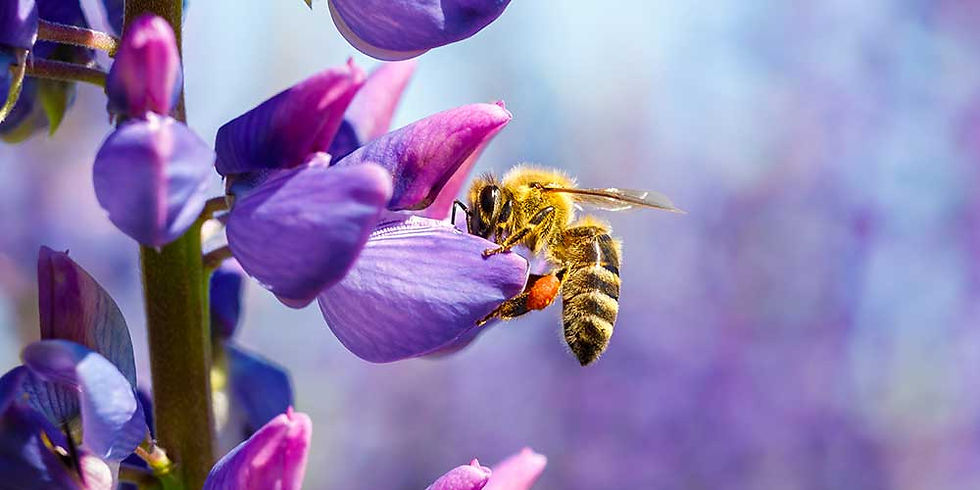How much of your food comes from bees? It's way more than just honey.

Bees are the unsung heroes of the kitchen. This isn't only for their delicious honey but for their fundamental role in pollination. Pollinators are responsible for a full third of the food humans eat, including almonds, apples, strawberries, pumpkins, and much much more.
Pollinators
Flowering plants use pollen to reproduce. Pollen has to move from one part of a flower to another, or from one plant to another, to create seeds and fruit and continue the life cycle. Though some pollen can be spread by wind or other inanimate methods, 75% to 95% of plants rely on animals to help them reproduce! Hummingbirds, bats, and insects are all essential pollinators, but bees are the pollen superstars.
Some 150 North American crops rely on pollinators for mass production, including fruits, vegetables, and nuts. Here are just a few of the foods that we wouldn't have on our plates without bees:
Almonds Apples Asparagus
Beans Beets Blackberries
Blueberries Brussels sprouts Buckwheat
Cabbage Cantaloupe Cauliflower
Celery Cherries Chestnuts
Chives Clover Cranberries
Cucumber Currants Eggplant
Flax Garlic Grapes
Horseradish Kale Lettuce
Mustard Onions Parsley
Peaches Pears Plums
Pumpkins Radishes Raspberries
Rhubarb Squash Strawberries
Sweet potatoes Turnips Watermelon
Bees are also essential pollinators for alfalfa, an affordable protein source fed to beef and dairy cattle, especially during the winter. So, red meat and dairy prices would probably increase without bees.
Cosmetics would also have to change without bees. Many lipsticks, chapsticks, lotions and balms use beeswax to hold their shape and texture. Bar soaps utilize beeswax as well.

With so many foods and other everyday products depending on bees and other pollinators, you can see why people are worried about the decline in bee populations. This downward trend isn't only happening in North America but can be seen worldwide. Scientists don't fully understand the causes behind this decline, but the widespread use of pesticides and habitat loss are almost certainly contributing factors. The good news is, there are simple and fun ways you can help.
Plant Some Wildflowers
Bees and other pollinators rely on local flowers for food. Green grass lawns are like a barren desert, offering no supplies as they travel from place to place. The same is true for large fields of some monoculture crops. If you leave a small corner of your yard or property for native plants to grow, this gives them a little oasis to refuel on their journeys. All it takes is a single piece of a flowerbed to feed a wide variety of local species.
For the most impact, pick three types of wildflowers native to your area, one that blooms in spring, one that blooms in summer, and one that blooms in fall. You can mix them all together for a natural look or separate them into their own tidy garden patches. This way, pollinating visitors will always have a snack, and you will always have a spot of natural color to enjoy!
Avoid Harmful Pesticides
Don't use any chemical herbicides, chemical pesticides, or chemical fertilizers on your wildflowers. It's best if you can avoid them as much as possible throughout your yard or garden. If you do use them, check labels and avoid anything that uses neonicotinoids. These are harmful to bees and are a likely contributor to their current decline.
Throw Seed Balls
Your yard isn't the only space for native wildflowers. Empty lots, highway medians, and roadside slopes are all perfect homes for native plants. Since not all these areas are easy to get to, seed balls are a great way to introduce wildflowers without needing to set foot on the soil or behind a fence.
Seed balls are just what they sound like, little balls made of native seeds, soil, and a little clay to hold them all together. They're small and light, and you can easily toss them over a fence or across a road into a hard-to-access area. They're fun to make, but you can also purchase them. Just make sure you're using seeds that are native to your area.
An extra benefit to spreading or planting local wildflowers is the other pollinators they attract. Not everyone is fond of bees, but these plants also attract gorgeous butterflies and flashy hummingbirds. They're good for the whole local ecosystem.

Share the Love
Bees and other pollinators face many challenges right now, but you can help bolster their ecosystem, which, in turn, will strengthen our human food chain. They pollinate so many delicious foods for us, it seems only fair to plant a few snacks for them in return! With Earth Day just around the corner, it's a great way to say thanks to the bees and help strengthen our own food chain at the same time.
If you liked this article, consider subscribing up top! We have new recipes, natural beauty tips, health and wellness routines, and more sweet treats posting every other week.
If you're feeling grateful to these hardworking bees, please share this post on any social platform you like! The more awareness we can spread about protecting helpful pollinators, the better their chances to survive and thrive!
If you're curious about bees and want to know more about their many talents, check out these other posts:
We have new recipes, natural beauty tips, health and wellness routines, and more sweet treats posting every other week!
Need some pure raw honey right away? Chances are good it's available in a store near you!
Or, order Don Victor™ Pure Honey or Don Victor™ Pure Honey with Comb online to be delivered straight to your door!
Comments